Social Research Essay: Canadian Immigration and Social Inequality
VerifiedAdded on 2023/01/13
|8
|2127
|80
Essay
AI Summary
This essay delves into the social landscape of Canada prior to the implementation of the Points System in 1967, examining the interplay of gender roles, racial issues, and immigration. It highlights the experiences of marginalized groups, particularly women and racial minorities, and how they were impacted by societal biases and discriminatory practices. The essay discusses the prevalence of stereotypical behaviors and assumptions that created challenges for immigrants, and how these issues were often exacerbated in workplaces. It also touches upon the naturalization of racism and the linguistic barriers that contributed to social inequalities. The essay concludes by emphasizing the importance of national integration and the need for policies that foster equality and address the negative impacts of multiculturalism. The essay uses various sources to discuss the complexities of Canadian society and immigration policies.
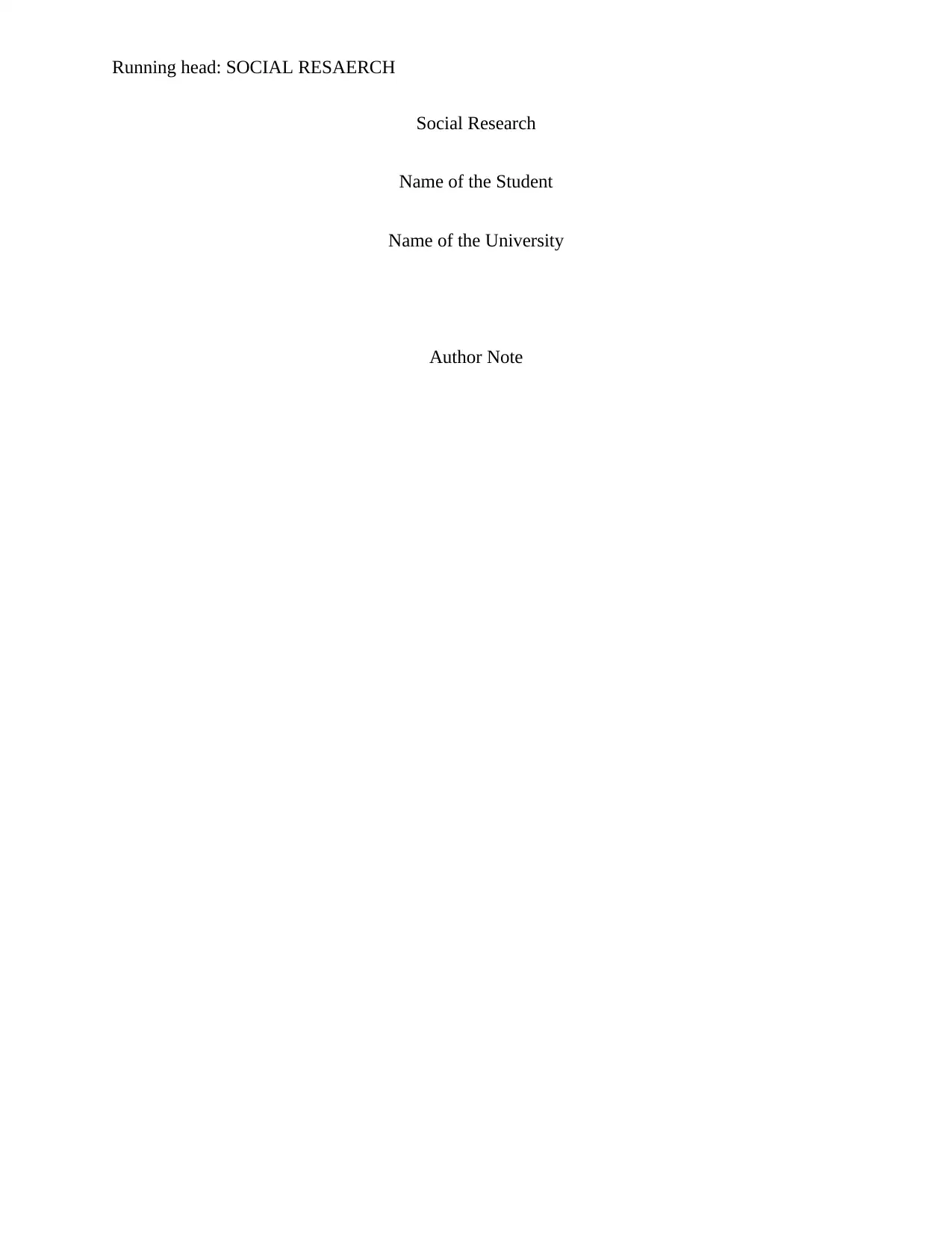
Running head: SOCIAL RESAERCH
Social Research
Name of the Student
Name of the University
Author Note
Social Research
Name of the Student
Name of the University
Author Note
Paraphrase This Document
Need a fresh take? Get an instant paraphrase of this document with our AI Paraphraser
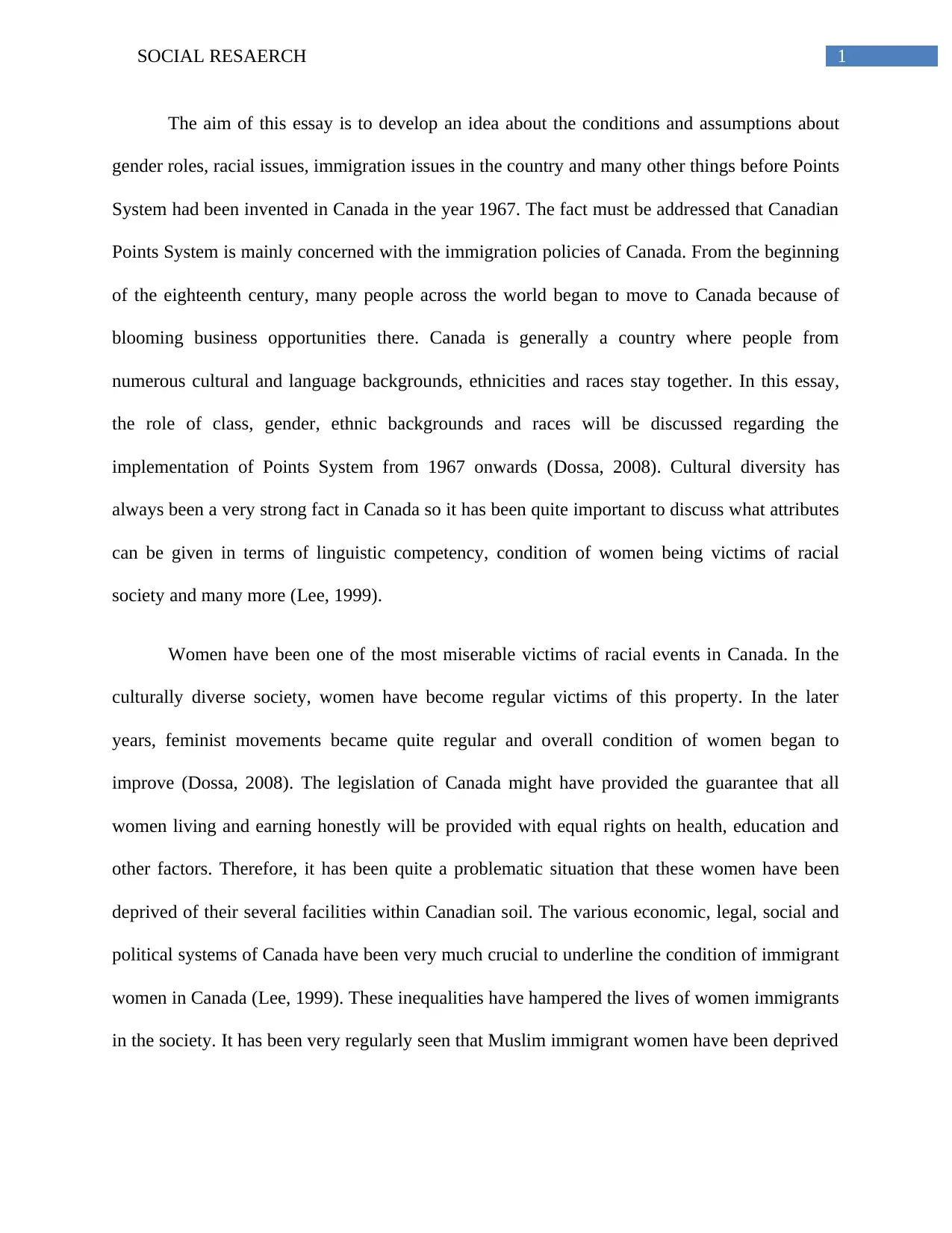
1SOCIAL RESAERCH
The aim of this essay is to develop an idea about the conditions and assumptions about
gender roles, racial issues, immigration issues in the country and many other things before Points
System had been invented in Canada in the year 1967. The fact must be addressed that Canadian
Points System is mainly concerned with the immigration policies of Canada. From the beginning
of the eighteenth century, many people across the world began to move to Canada because of
blooming business opportunities there. Canada is generally a country where people from
numerous cultural and language backgrounds, ethnicities and races stay together. In this essay,
the role of class, gender, ethnic backgrounds and races will be discussed regarding the
implementation of Points System from 1967 onwards (Dossa, 2008). Cultural diversity has
always been a very strong fact in Canada so it has been quite important to discuss what attributes
can be given in terms of linguistic competency, condition of women being victims of racial
society and many more (Lee, 1999).
Women have been one of the most miserable victims of racial events in Canada. In the
culturally diverse society, women have become regular victims of this property. In the later
years, feminist movements became quite regular and overall condition of women began to
improve (Dossa, 2008). The legislation of Canada might have provided the guarantee that all
women living and earning honestly will be provided with equal rights on health, education and
other factors. Therefore, it has been quite a problematic situation that these women have been
deprived of their several facilities within Canadian soil. The various economic, legal, social and
political systems of Canada have been very much crucial to underline the condition of immigrant
women in Canada (Lee, 1999). These inequalities have hampered the lives of women immigrants
in the society. It has been very regularly seen that Muslim immigrant women have been deprived
The aim of this essay is to develop an idea about the conditions and assumptions about
gender roles, racial issues, immigration issues in the country and many other things before Points
System had been invented in Canada in the year 1967. The fact must be addressed that Canadian
Points System is mainly concerned with the immigration policies of Canada. From the beginning
of the eighteenth century, many people across the world began to move to Canada because of
blooming business opportunities there. Canada is generally a country where people from
numerous cultural and language backgrounds, ethnicities and races stay together. In this essay,
the role of class, gender, ethnic backgrounds and races will be discussed regarding the
implementation of Points System from 1967 onwards (Dossa, 2008). Cultural diversity has
always been a very strong fact in Canada so it has been quite important to discuss what attributes
can be given in terms of linguistic competency, condition of women being victims of racial
society and many more (Lee, 1999).
Women have been one of the most miserable victims of racial events in Canada. In the
culturally diverse society, women have become regular victims of this property. In the later
years, feminist movements became quite regular and overall condition of women began to
improve (Dossa, 2008). The legislation of Canada might have provided the guarantee that all
women living and earning honestly will be provided with equal rights on health, education and
other factors. Therefore, it has been quite a problematic situation that these women have been
deprived of their several facilities within Canadian soil. The various economic, legal, social and
political systems of Canada have been very much crucial to underline the condition of immigrant
women in Canada (Lee, 1999). These inequalities have hampered the lives of women immigrants
in the society. It has been very regularly seen that Muslim immigrant women have been deprived
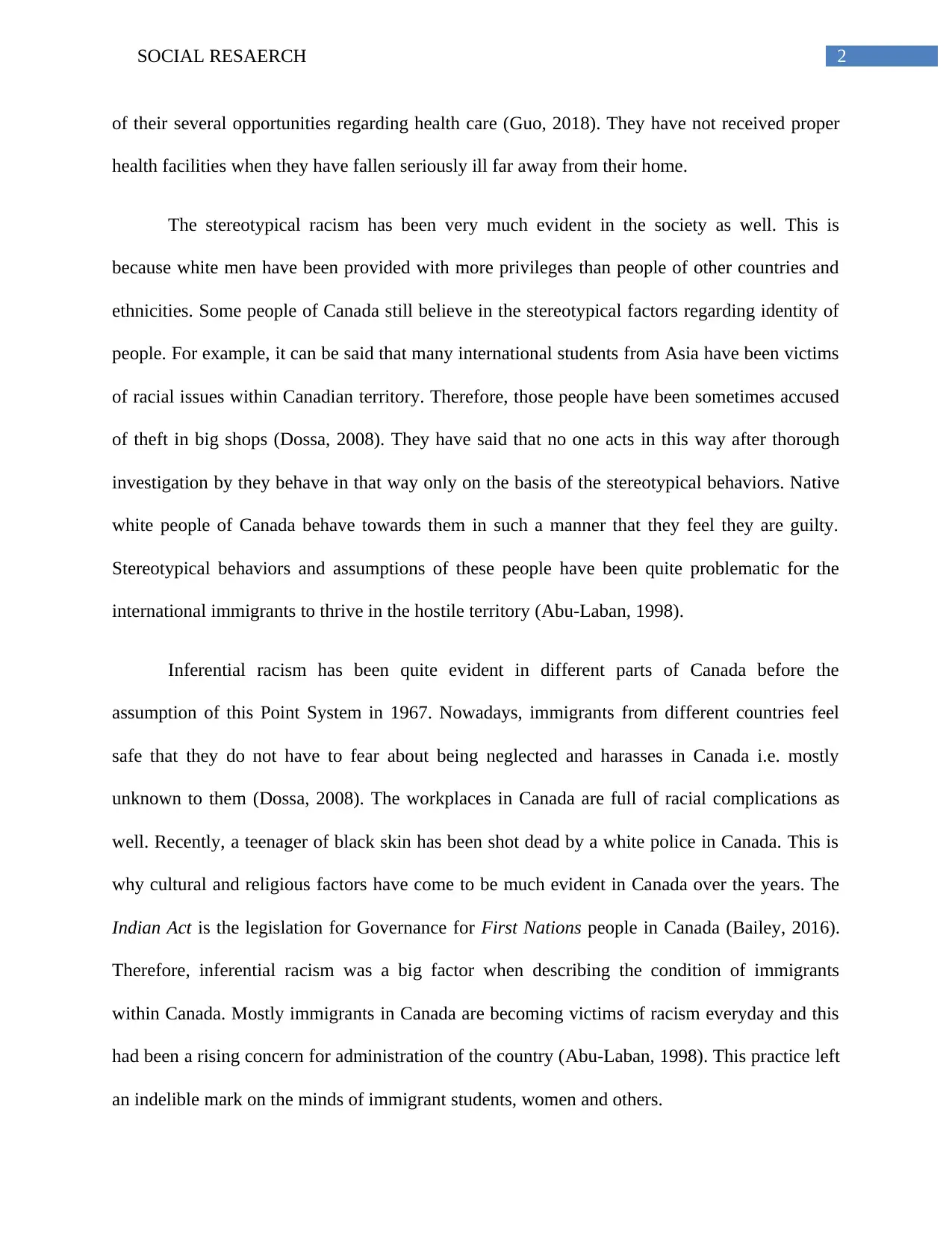
2SOCIAL RESAERCH
of their several opportunities regarding health care (Guo, 2018). They have not received proper
health facilities when they have fallen seriously ill far away from their home.
The stereotypical racism has been very much evident in the society as well. This is
because white men have been provided with more privileges than people of other countries and
ethnicities. Some people of Canada still believe in the stereotypical factors regarding identity of
people. For example, it can be said that many international students from Asia have been victims
of racial issues within Canadian territory. Therefore, those people have been sometimes accused
of theft in big shops (Dossa, 2008). They have said that no one acts in this way after thorough
investigation by they behave in that way only on the basis of the stereotypical behaviors. Native
white people of Canada behave towards them in such a manner that they feel they are guilty.
Stereotypical behaviors and assumptions of these people have been quite problematic for the
international immigrants to thrive in the hostile territory (Abu-Laban, 1998).
Inferential racism has been quite evident in different parts of Canada before the
assumption of this Point System in 1967. Nowadays, immigrants from different countries feel
safe that they do not have to fear about being neglected and harasses in Canada i.e. mostly
unknown to them (Dossa, 2008). The workplaces in Canada are full of racial complications as
well. Recently, a teenager of black skin has been shot dead by a white police in Canada. This is
why cultural and religious factors have come to be much evident in Canada over the years. The
Indian Act is the legislation for Governance for First Nations people in Canada (Bailey, 2016).
Therefore, inferential racism was a big factor when describing the condition of immigrants
within Canada. Mostly immigrants in Canada are becoming victims of racism everyday and this
had been a rising concern for administration of the country (Abu-Laban, 1998). This practice left
an indelible mark on the minds of immigrant students, women and others.
of their several opportunities regarding health care (Guo, 2018). They have not received proper
health facilities when they have fallen seriously ill far away from their home.
The stereotypical racism has been very much evident in the society as well. This is
because white men have been provided with more privileges than people of other countries and
ethnicities. Some people of Canada still believe in the stereotypical factors regarding identity of
people. For example, it can be said that many international students from Asia have been victims
of racial issues within Canadian territory. Therefore, those people have been sometimes accused
of theft in big shops (Dossa, 2008). They have said that no one acts in this way after thorough
investigation by they behave in that way only on the basis of the stereotypical behaviors. Native
white people of Canada behave towards them in such a manner that they feel they are guilty.
Stereotypical behaviors and assumptions of these people have been quite problematic for the
international immigrants to thrive in the hostile territory (Abu-Laban, 1998).
Inferential racism has been quite evident in different parts of Canada before the
assumption of this Point System in 1967. Nowadays, immigrants from different countries feel
safe that they do not have to fear about being neglected and harasses in Canada i.e. mostly
unknown to them (Dossa, 2008). The workplaces in Canada are full of racial complications as
well. Recently, a teenager of black skin has been shot dead by a white police in Canada. This is
why cultural and religious factors have come to be much evident in Canada over the years. The
Indian Act is the legislation for Governance for First Nations people in Canada (Bailey, 2016).
Therefore, inferential racism was a big factor when describing the condition of immigrants
within Canada. Mostly immigrants in Canada are becoming victims of racism everyday and this
had been a rising concern for administration of the country (Abu-Laban, 1998). This practice left
an indelible mark on the minds of immigrant students, women and others.
⊘ This is a preview!⊘
Do you want full access?
Subscribe today to unlock all pages.

Trusted by 1+ million students worldwide
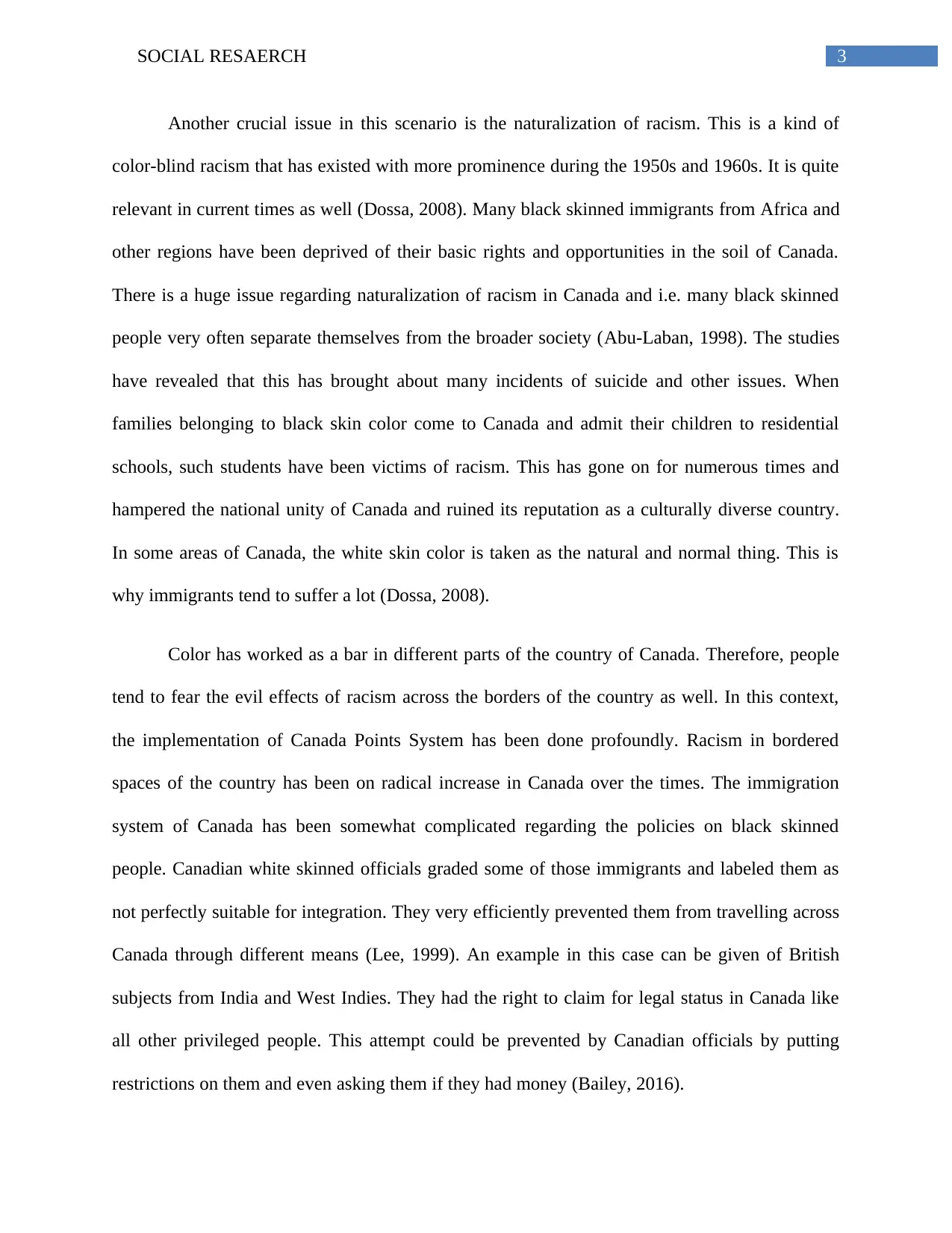
3SOCIAL RESAERCH
Another crucial issue in this scenario is the naturalization of racism. This is a kind of
color-blind racism that has existed with more prominence during the 1950s and 1960s. It is quite
relevant in current times as well (Dossa, 2008). Many black skinned immigrants from Africa and
other regions have been deprived of their basic rights and opportunities in the soil of Canada.
There is a huge issue regarding naturalization of racism in Canada and i.e. many black skinned
people very often separate themselves from the broader society (Abu-Laban, 1998). The studies
have revealed that this has brought about many incidents of suicide and other issues. When
families belonging to black skin color come to Canada and admit their children to residential
schools, such students have been victims of racism. This has gone on for numerous times and
hampered the national unity of Canada and ruined its reputation as a culturally diverse country.
In some areas of Canada, the white skin color is taken as the natural and normal thing. This is
why immigrants tend to suffer a lot (Dossa, 2008).
Color has worked as a bar in different parts of the country of Canada. Therefore, people
tend to fear the evil effects of racism across the borders of the country as well. In this context,
the implementation of Canada Points System has been done profoundly. Racism in bordered
spaces of the country has been on radical increase in Canada over the times. The immigration
system of Canada has been somewhat complicated regarding the policies on black skinned
people. Canadian white skinned officials graded some of those immigrants and labeled them as
not perfectly suitable for integration. They very efficiently prevented them from travelling across
Canada through different means (Lee, 1999). An example in this case can be given of British
subjects from India and West Indies. They had the right to claim for legal status in Canada like
all other privileged people. This attempt could be prevented by Canadian officials by putting
restrictions on them and even asking them if they had money (Bailey, 2016).
Another crucial issue in this scenario is the naturalization of racism. This is a kind of
color-blind racism that has existed with more prominence during the 1950s and 1960s. It is quite
relevant in current times as well (Dossa, 2008). Many black skinned immigrants from Africa and
other regions have been deprived of their basic rights and opportunities in the soil of Canada.
There is a huge issue regarding naturalization of racism in Canada and i.e. many black skinned
people very often separate themselves from the broader society (Abu-Laban, 1998). The studies
have revealed that this has brought about many incidents of suicide and other issues. When
families belonging to black skin color come to Canada and admit their children to residential
schools, such students have been victims of racism. This has gone on for numerous times and
hampered the national unity of Canada and ruined its reputation as a culturally diverse country.
In some areas of Canada, the white skin color is taken as the natural and normal thing. This is
why immigrants tend to suffer a lot (Dossa, 2008).
Color has worked as a bar in different parts of the country of Canada. Therefore, people
tend to fear the evil effects of racism across the borders of the country as well. In this context,
the implementation of Canada Points System has been done profoundly. Racism in bordered
spaces of the country has been on radical increase in Canada over the times. The immigration
system of Canada has been somewhat complicated regarding the policies on black skinned
people. Canadian white skinned officials graded some of those immigrants and labeled them as
not perfectly suitable for integration. They very efficiently prevented them from travelling across
Canada through different means (Lee, 1999). An example in this case can be given of British
subjects from India and West Indies. They had the right to claim for legal status in Canada like
all other privileged people. This attempt could be prevented by Canadian officials by putting
restrictions on them and even asking them if they had money (Bailey, 2016).
Paraphrase This Document
Need a fresh take? Get an instant paraphrase of this document with our AI Paraphraser
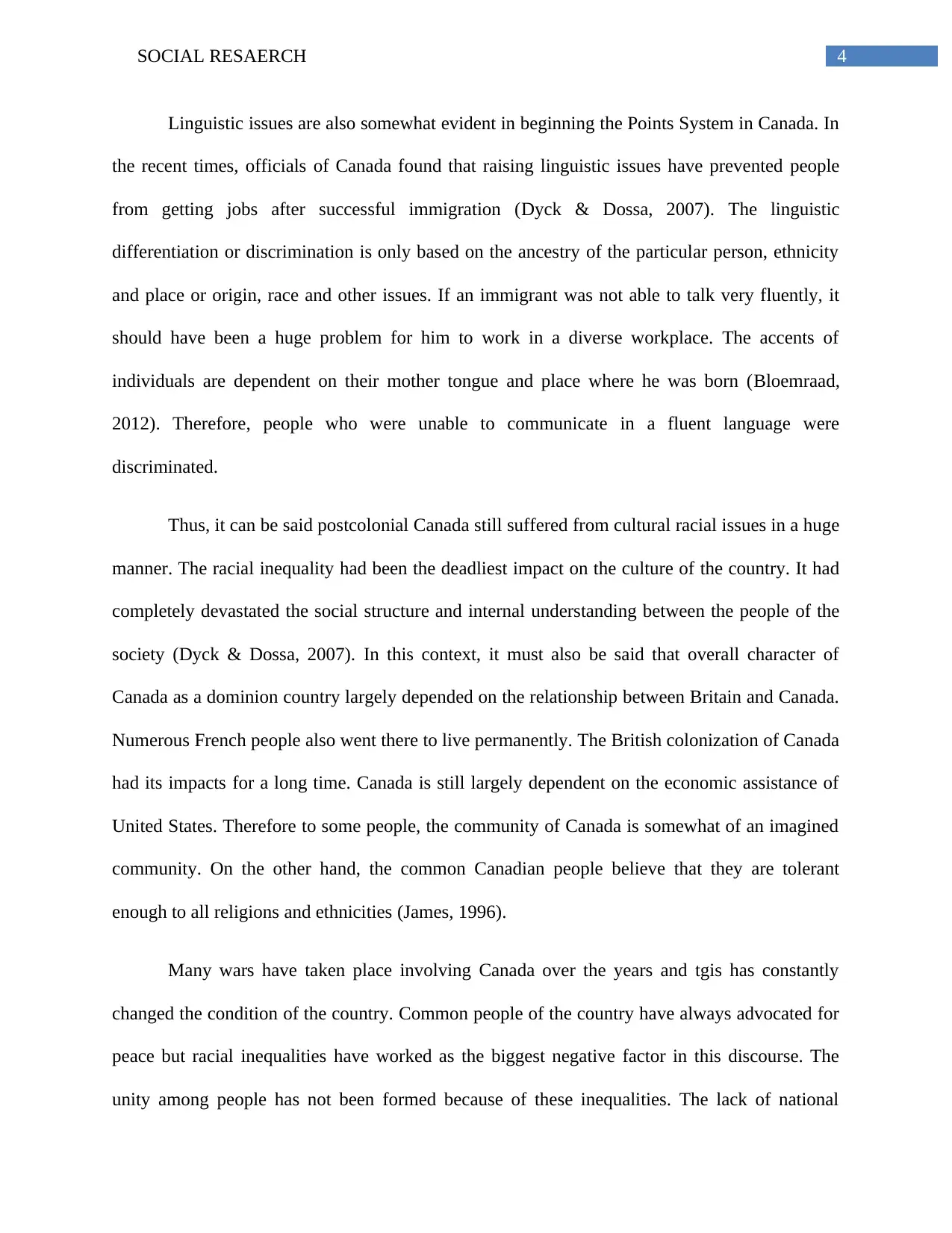
4SOCIAL RESAERCH
Linguistic issues are also somewhat evident in beginning the Points System in Canada. In
the recent times, officials of Canada found that raising linguistic issues have prevented people
from getting jobs after successful immigration (Dyck & Dossa, 2007). The linguistic
differentiation or discrimination is only based on the ancestry of the particular person, ethnicity
and place or origin, race and other issues. If an immigrant was not able to talk very fluently, it
should have been a huge problem for him to work in a diverse workplace. The accents of
individuals are dependent on their mother tongue and place where he was born (Bloemraad,
2012). Therefore, people who were unable to communicate in a fluent language were
discriminated.
Thus, it can be said postcolonial Canada still suffered from cultural racial issues in a huge
manner. The racial inequality had been the deadliest impact on the culture of the country. It had
completely devastated the social structure and internal understanding between the people of the
society (Dyck & Dossa, 2007). In this context, it must also be said that overall character of
Canada as a dominion country largely depended on the relationship between Britain and Canada.
Numerous French people also went there to live permanently. The British colonization of Canada
had its impacts for a long time. Canada is still largely dependent on the economic assistance of
United States. Therefore to some people, the community of Canada is somewhat of an imagined
community. On the other hand, the common Canadian people believe that they are tolerant
enough to all religions and ethnicities (James, 1996).
Many wars have taken place involving Canada over the years and tgis has constantly
changed the condition of the country. Common people of the country have always advocated for
peace but racial inequalities have worked as the biggest negative factor in this discourse. The
unity among people has not been formed because of these inequalities. The lack of national
Linguistic issues are also somewhat evident in beginning the Points System in Canada. In
the recent times, officials of Canada found that raising linguistic issues have prevented people
from getting jobs after successful immigration (Dyck & Dossa, 2007). The linguistic
differentiation or discrimination is only based on the ancestry of the particular person, ethnicity
and place or origin, race and other issues. If an immigrant was not able to talk very fluently, it
should have been a huge problem for him to work in a diverse workplace. The accents of
individuals are dependent on their mother tongue and place where he was born (Bloemraad,
2012). Therefore, people who were unable to communicate in a fluent language were
discriminated.
Thus, it can be said postcolonial Canada still suffered from cultural racial issues in a huge
manner. The racial inequality had been the deadliest impact on the culture of the country. It had
completely devastated the social structure and internal understanding between the people of the
society (Dyck & Dossa, 2007). In this context, it must also be said that overall character of
Canada as a dominion country largely depended on the relationship between Britain and Canada.
Numerous French people also went there to live permanently. The British colonization of Canada
had its impacts for a long time. Canada is still largely dependent on the economic assistance of
United States. Therefore to some people, the community of Canada is somewhat of an imagined
community. On the other hand, the common Canadian people believe that they are tolerant
enough to all religions and ethnicities (James, 1996).
Many wars have taken place involving Canada over the years and tgis has constantly
changed the condition of the country. Common people of the country have always advocated for
peace but racial inequalities have worked as the biggest negative factor in this discourse. The
unity among people has not been formed because of these inequalities. The lack of national
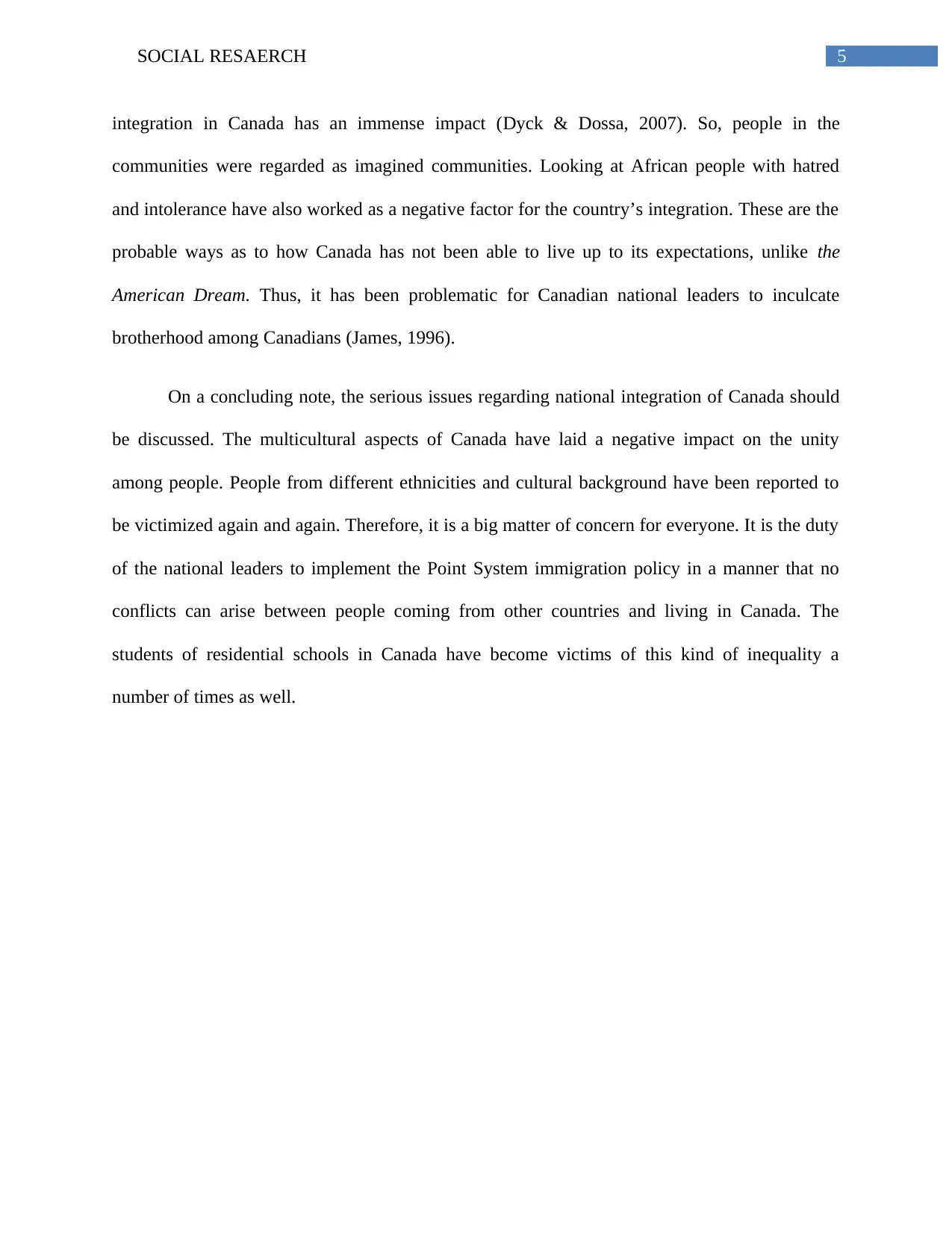
5SOCIAL RESAERCH
integration in Canada has an immense impact (Dyck & Dossa, 2007). So, people in the
communities were regarded as imagined communities. Looking at African people with hatred
and intolerance have also worked as a negative factor for the country’s integration. These are the
probable ways as to how Canada has not been able to live up to its expectations, unlike the
American Dream. Thus, it has been problematic for Canadian national leaders to inculcate
brotherhood among Canadians (James, 1996).
On a concluding note, the serious issues regarding national integration of Canada should
be discussed. The multicultural aspects of Canada have laid a negative impact on the unity
among people. People from different ethnicities and cultural background have been reported to
be victimized again and again. Therefore, it is a big matter of concern for everyone. It is the duty
of the national leaders to implement the Point System immigration policy in a manner that no
conflicts can arise between people coming from other countries and living in Canada. The
students of residential schools in Canada have become victims of this kind of inequality a
number of times as well.
integration in Canada has an immense impact (Dyck & Dossa, 2007). So, people in the
communities were regarded as imagined communities. Looking at African people with hatred
and intolerance have also worked as a negative factor for the country’s integration. These are the
probable ways as to how Canada has not been able to live up to its expectations, unlike the
American Dream. Thus, it has been problematic for Canadian national leaders to inculcate
brotherhood among Canadians (James, 1996).
On a concluding note, the serious issues regarding national integration of Canada should
be discussed. The multicultural aspects of Canada have laid a negative impact on the unity
among people. People from different ethnicities and cultural background have been reported to
be victimized again and again. Therefore, it is a big matter of concern for everyone. It is the duty
of the national leaders to implement the Point System immigration policy in a manner that no
conflicts can arise between people coming from other countries and living in Canada. The
students of residential schools in Canada have become victims of this kind of inequality a
number of times as well.
⊘ This is a preview!⊘
Do you want full access?
Subscribe today to unlock all pages.

Trusted by 1+ million students worldwide
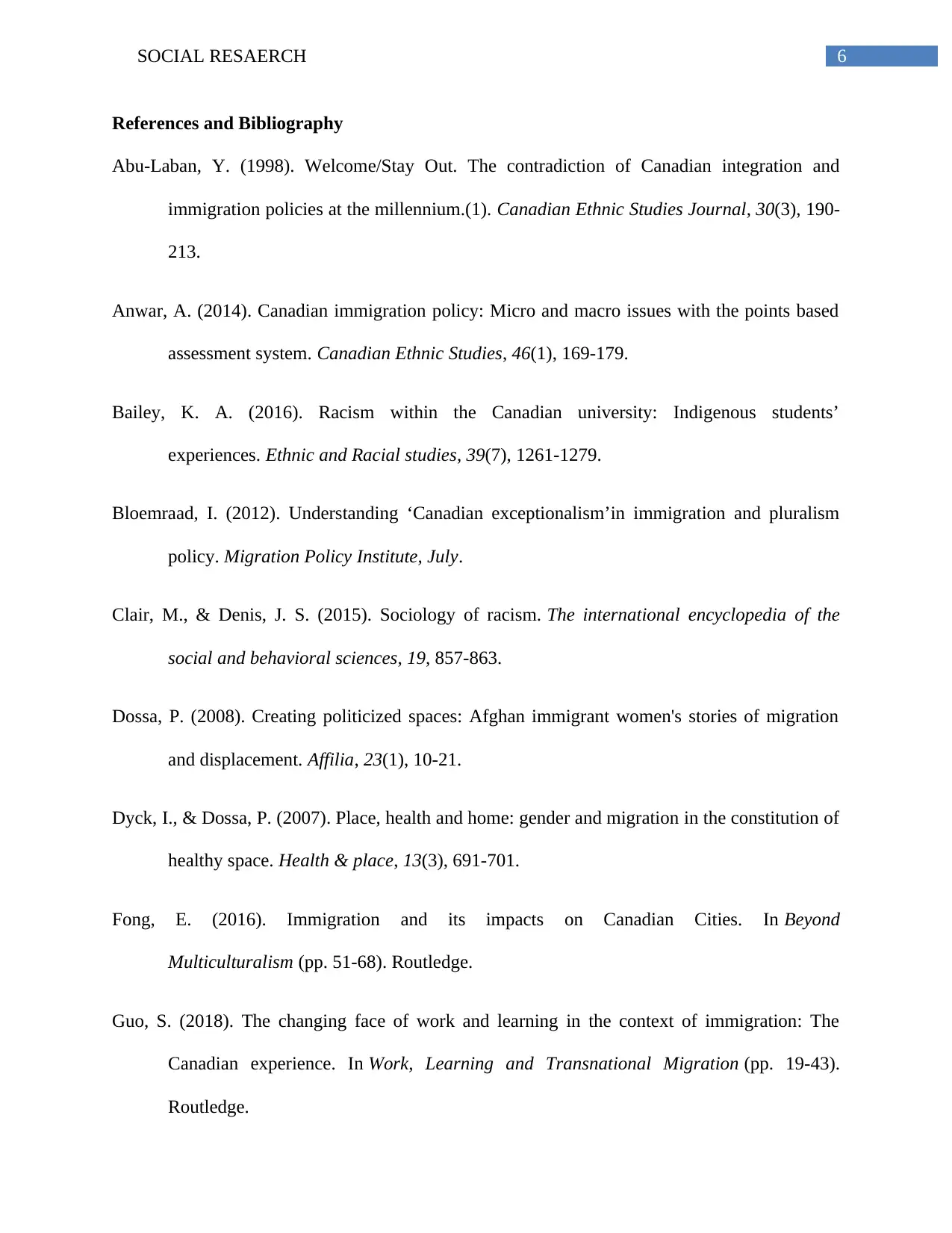
6SOCIAL RESAERCH
References and Bibliography
Abu-Laban, Y. (1998). Welcome/Stay Out. The contradiction of Canadian integration and
immigration policies at the millennium.(1). Canadian Ethnic Studies Journal, 30(3), 190-
213.
Anwar, A. (2014). Canadian immigration policy: Micro and macro issues with the points based
assessment system. Canadian Ethnic Studies, 46(1), 169-179.
Bailey, K. A. (2016). Racism within the Canadian university: Indigenous students’
experiences. Ethnic and Racial studies, 39(7), 1261-1279.
Bloemraad, I. (2012). Understanding ‘Canadian exceptionalism’in immigration and pluralism
policy. Migration Policy Institute, July.
Clair, M., & Denis, J. S. (2015). Sociology of racism. The international encyclopedia of the
social and behavioral sciences, 19, 857-863.
Dossa, P. (2008). Creating politicized spaces: Afghan immigrant women's stories of migration
and displacement. Affilia, 23(1), 10-21.
Dyck, I., & Dossa, P. (2007). Place, health and home: gender and migration in the constitution of
healthy space. Health & place, 13(3), 691-701.
Fong, E. (2016). Immigration and its impacts on Canadian Cities. In Beyond
Multiculturalism (pp. 51-68). Routledge.
Guo, S. (2018). The changing face of work and learning in the context of immigration: The
Canadian experience. In Work, Learning and Transnational Migration (pp. 19-43).
Routledge.
References and Bibliography
Abu-Laban, Y. (1998). Welcome/Stay Out. The contradiction of Canadian integration and
immigration policies at the millennium.(1). Canadian Ethnic Studies Journal, 30(3), 190-
213.
Anwar, A. (2014). Canadian immigration policy: Micro and macro issues with the points based
assessment system. Canadian Ethnic Studies, 46(1), 169-179.
Bailey, K. A. (2016). Racism within the Canadian university: Indigenous students’
experiences. Ethnic and Racial studies, 39(7), 1261-1279.
Bloemraad, I. (2012). Understanding ‘Canadian exceptionalism’in immigration and pluralism
policy. Migration Policy Institute, July.
Clair, M., & Denis, J. S. (2015). Sociology of racism. The international encyclopedia of the
social and behavioral sciences, 19, 857-863.
Dossa, P. (2008). Creating politicized spaces: Afghan immigrant women's stories of migration
and displacement. Affilia, 23(1), 10-21.
Dyck, I., & Dossa, P. (2007). Place, health and home: gender and migration in the constitution of
healthy space. Health & place, 13(3), 691-701.
Fong, E. (2016). Immigration and its impacts on Canadian Cities. In Beyond
Multiculturalism (pp. 51-68). Routledge.
Guo, S. (2018). The changing face of work and learning in the context of immigration: The
Canadian experience. In Work, Learning and Transnational Migration (pp. 19-43).
Routledge.
Paraphrase This Document
Need a fresh take? Get an instant paraphrase of this document with our AI Paraphraser
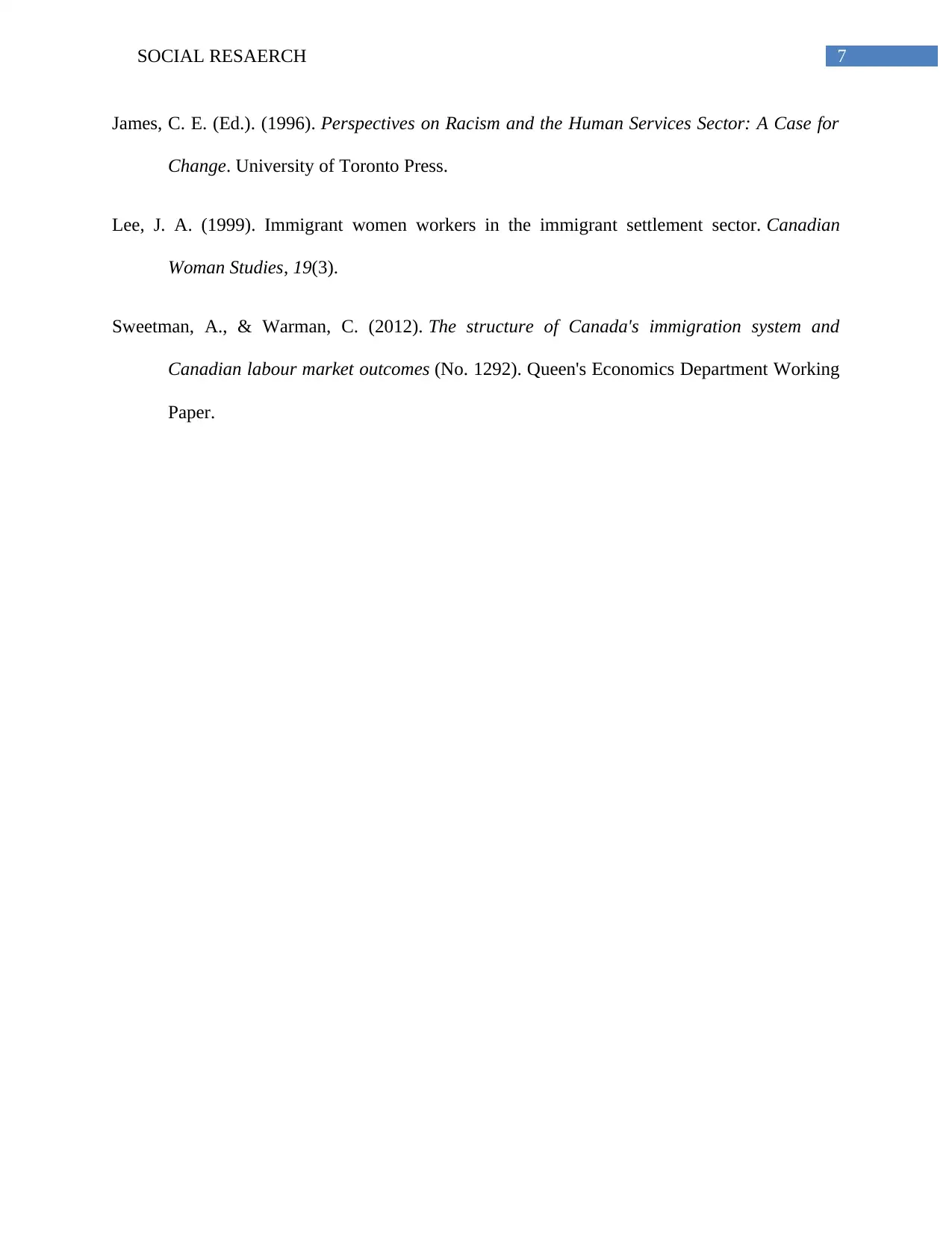
7SOCIAL RESAERCH
James, C. E. (Ed.). (1996). Perspectives on Racism and the Human Services Sector: A Case for
Change. University of Toronto Press.
Lee, J. A. (1999). Immigrant women workers in the immigrant settlement sector. Canadian
Woman Studies, 19(3).
Sweetman, A., & Warman, C. (2012). The structure of Canada's immigration system and
Canadian labour market outcomes (No. 1292). Queen's Economics Department Working
Paper.
James, C. E. (Ed.). (1996). Perspectives on Racism and the Human Services Sector: A Case for
Change. University of Toronto Press.
Lee, J. A. (1999). Immigrant women workers in the immigrant settlement sector. Canadian
Woman Studies, 19(3).
Sweetman, A., & Warman, C. (2012). The structure of Canada's immigration system and
Canadian labour market outcomes (No. 1292). Queen's Economics Department Working
Paper.
1 out of 8
Your All-in-One AI-Powered Toolkit for Academic Success.
+13062052269
info@desklib.com
Available 24*7 on WhatsApp / Email
![[object Object]](/_next/static/media/star-bottom.7253800d.svg)
Unlock your academic potential
Copyright © 2020–2025 A2Z Services. All Rights Reserved. Developed and managed by ZUCOL.
